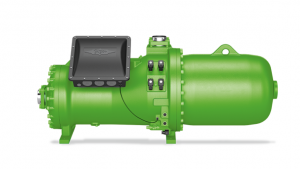When the screw refrigeration unit is started, the first thing to know is whether the refrigeration system is operating normally. The following is a brief introduction to the content and signs of normal operation, and the following is for reference only:
The cooling water of the condenser should be sufficient, the water pressure should be above 0.12MPa, and the water temperature should not be too high.
For screw refrigeration units, the reading of the oil pump pressure gauge should be 0.15~0.3MPa higher than the exhaust pressure.

Under any circumstances, the oil temperature should not exceed 70°C for fluorine refrigeration unit and 65°C for ammonia refrigerators, and the minimum should not be lower than 30°C. Under normal operating conditions, the lubricating oil should not foam (except for fluorine refrigeration unit).
Refrigeration unit discharge temperature. Ammonia and R22 do not exceed 135°C, and if the exhaust gas temperature rises further, it will be very small compared with the flash point of the refrigeration oil (160°C), which is not good for the equipment. Therefore, from the point of view of use, the exhaust temperature should not be too high, and if it is too high, it should be stopped to find out the reason.
The level of condensing pressure. It is mainly determined according to the water source, the structure of the condenser and the refrigerant used. The liquid level of the reservoir shall not be lower than one-third of the liquid level indicator, and the oil level of the crankcase shall not be lower than the horizontal center line of the indicator window.
The automatic oil return pipe of the fluorine oil separator is normal when it is cold and hot, and the cold and hot cycle is about 1 hour. There should be no obvious temperature difference before and after the filter of the liquid pipeline. There should be no frosting, otherwise it will be blocked. The fluorine refrigerator should be cool on the flat side and hot on the dry side. The joints of the fluorine system should not leak oil, which means fluorine leakage.
When touching the horizontal condenser during operation, the upper part should be hot and the lower part should be cool. The junction of cold and hot is the refrigerant liquid level. The oil separator is also hot at the upper part, and the lower part is not too hot. The safety valve or bypass valve of the refrigerator should feel cool at the low pressure end, if it is not cool, it means high and low pressure air leakage.
During operation, the steam pressure should be similar to the suction pressure, and the exhaust pressure at the high-pressure end should be similar to the condensing pressure and the pressure of the liquid receiver. If not, it is abnormal.
Under a certain water flow rate, there should be a temperature difference between the inlet and outlet of the cooling water. If there is no temperature difference or a very slight temperature difference, it means that the heat transfer surface of the heat exchange equipment is dirty and needs to be shut down for cleaning.
The refrigerator itself should be sealed and must not leak refrigerant and lubricating oil. For the shaft seal, when the standard cooling capacity is 12.6×1000 kJ/h, the shaft seal is allowed to have a small amount of oil leakage, and the refrigerator with the standard cooling capacity > 12.6×1000 kJ/h is not allowed to have no more than 10 drops of oil leakage per hour Phenomenon, the shaft seal of the fluorine refrigeration unit must not have oil dripping.
The temperature of the shaft seal and bearing of the refrigerator should not exceed 70°C.
Frost or dew on the expansion valve is uniform, but thick frost should not appear at the inlet.
Post time: Mar-13-2023




